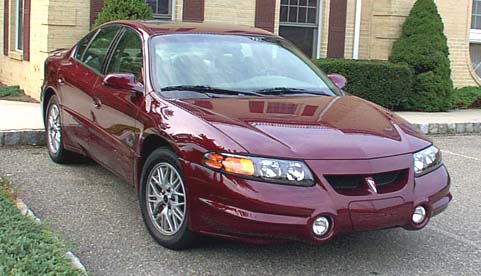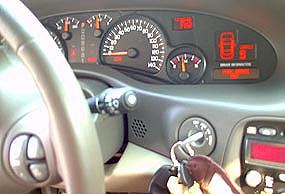 |
|
|
||||||||||||||||||||||||||||||||
For years, the Pontiac Bonneville has provided a mix of luxury and performance, aided by a supercharged 3.8 liter engine. With the supercharger, it can out-accelerate the Chrysler 300M, but cannot outrace it on the curvies. Without the supercharger, it's still a decent match.
We loved the Bonneville's drivetrain, with its ready-to-please transmission and quiet, capable engine. The transmission downshifts easily, so it can have a high top gear without punishing performance. It shifts more smoothly than the 300M, so the downshifting is not unpleasant. (Yes, the 300M has AutoStick, but the Bonneville doesn't need AutoStick). The exhaust has also been tuned to produce a performance sound. As a final gesture, large rectangular exhaust tips have been stuck onto the round tailpipes. (We did not drive the supercharged version).
Though handling is not up to the 300M, the Bonneville feels sure-footed. The Eagle RS-A tires help - they are good both in wet and dry weather. The ride is very good, with few road imperfections coming through to the driver. You can feel the road, but not be hurt by it.
 |
The fan uses the same small round vents as the PT Cruiser, which use aerodynamics instead of louvers to direct air. This system works better and is quieter. Separate driver and passenger thermostats are optional.
The stereo is very good if a little gadget-happy, not a match for the Infinity system in the Chrysler but still very good.
The trip computer tells you if a tire's air pressure is low, and guesses about oil life. It also tells you gas mileage, but you might not want to know - it is about as low as with the 300M.
The center console is too far back; it has an internal coin-holder, but putting coins in requires a hard arm twist.
There are a variety of places to put odds and ends. Rear passengers get their own power jack, cupholders, and closing console.
 |
We did like one gadget; pressing a button switches the MPH on the speedometer to km/h, which explains why the speedometer goes up to 140 - that's 140 km/h as well as 140 MPH. The odometer and trip computer also change to kilometers and back.
While it would be nice for the 300M to adopt the metric conversion, it would mess up the elegant appearance. On the other hand, we would like the 300M to adopt the customization features of the Bonneville (and, for that matter, the Grand Cherokee). You can easily change options such as the automatic lighting and door locking through the trip computer. We also liked the latch-free gas cap lock; when the doors are locked, so is the gas cap.
In a feature now becoming common, Pontiac lets you use the radio and power windows until you open a door, rather than until you shut off the engine. Likewise, the lights go on when you remove the key, or when you unlock the doors. Door lights can prevent accidents.
Overall, the Bonneville is quite the 300M competitor. The price range is around that of the 300M; so is the interior and trunk space. Gas mileage, acceleration, and handling are similar, if in slightly different proportions. The 300M has much more elegant styling and seemed more comfortable, but the Bonneville's drivetrain was more pleasant and willing, even if our version was not quite as fast.
Both cars are worthy competitors to any imports. If you're looking for a large car or SUV in this price range, we strongly advise you to check out the Bonneville and 300M.